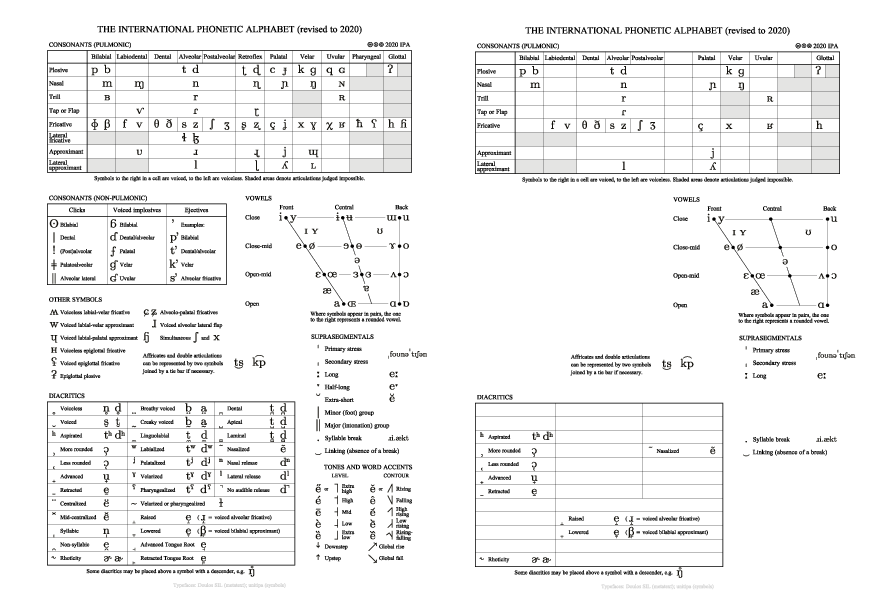1. International Phonetic Association, Handbook of the International Phonetic Association: a guide of the use of the International Phonetic Alphabet (New York: Cambridge University Press, 2007), 3.
2. Richard Miller, Solutions for singers: tools for performers and teachers [in English] (Oxford; New York: Oxford University Press,2004), 65–66, ISBN : 0195160053 9780195160055
3. Yvonne R. Dechance, Yvonne Dechance’s Frequently Asked Questions about Studying Voice Diction, 2008, accessed October 30, 2018, http://www.dictiondomain.com/cgi-bin/dd/dd_display.pl?action=show&sp=dictionfaq.
4. Ben Liberman, Operatic IPA, 2004, accessed December 1, 2018, http://itre.cis.upenn.edu/~myl/languagelog/archives/001230.html.
5. Corrie L.M. Minningh-Geeve, José Lieshout, and Corrie L.M. Minningh-Geeve, “Frans voor zangers,” NVZ Bulletin (Utrecht), no. 18 (2015): 12–13, https://www.zangpedagogen.nl/media/docs/2010-10-bulletin.pdf
6. The International Phonetic Alphabet and the IPA Chart, 2021, accessed January 17, 2021, https://www.internationalphoneticassociation.org/content/ipa-chart.
7. Miller, Solutions for singers: tools for performers and teachers, 66.
8. Miller, 65–66.
9. Joan Wall, International phonetic alphabet for singers: a manual for English and foreign language diction [in English] (Greenbank, Wash.: Pacific Isle Publishing, 2005), 4, ISBN : 1934477060 9781934477069.
The International Phonetic Alphabet (IPA) is, broadly speaking, a collection of symbols to represent practically every phoneme (language sound) of every language on earth.1 It is widely recommended by many singers and singing teachers in the world and many young singers are already introducted to the alphabet during their conservatory studies.234 While not quite the standard yet, most Dutch conservatories have at least one language class where the IPA is used.5 Impressively, the entire system easily fits on a single A4 paper, and is presented yearly in this way on the IPA chart.6
Richard Miller, in his book Solutions for Singers argues that a clean vowel definition is crucial to be aware of from language to language.7 "The IPA vowel system is a great assist in achieving phonetic exactitude", he elaborates.8 Similarly, Joan Wall in her International Phonetic Alphabet for Singers argues that as most of today's vocal pedagogy texts and research use the IPA, it is a great support for the singer wishing to stay abreast of the latest developments.9
Despite all that, many regard the IPA as useful, but too complex to actually use effectively. When looking at the IPA chart, one can see what they mean: on first glance, there are many alien-looking symbols on the chart presented in various tables labelled with complex words. However, in my experience many of the symbols of the IPA can be left out, without sacrificing convincing pronunciation while singing.
Bibliography
Dechance, Yvonne R. Yvonne Dechance’s Frequently Asked Questions about Studying Voice Diction, 2008.
Accessed October 30, 2018. http://www.dictiondomain.com/cgi-bin/dd/dd_display.pl?action=show&
sp=dictionfaq.
International Phonetic Association. Handbook of the International Phonetic Association: a guide of the use
of the International Phonetic Alphabet. New York: Cambridge University Press, 2007.
Liberman, Ben. Operatic IPA, 2004. Accessed December 1, 2018. http://itre.cis.upenn.edu/~myl/languagelog/
archives/001230.html.
Miller, Richard. Solutions for singers: tools for performers and teachers [in English]. Oxford; New York:
Oxford University Press, 2004. ISBN : 0195160053 9780195160055.
Minningh-Geeve, Corrie L.M., José Lieshout, and Corrie L.M. Minningh-Geeve. “Frans voor zangers.”
NVZ Bulletin (Utrecht), no. 18 (2015): 12–13. https://www.zangpedagogen.nl/media/docs/2010-10-
bulletin.pdf.
The International Phonetic Alphabet and the IPA Chart, 2021. Accessed January 17, 2021. https://www.
internationalphoneticassociation.org/content/ipa-chart.
Wall, Joan. International phonetic alphabet for singers : a manual for English and foreign language diction
[in English]. Greenbank, Wash.: Pacific Isle Publishing, 2005. ISBN : 1934477060 9781934477069.
